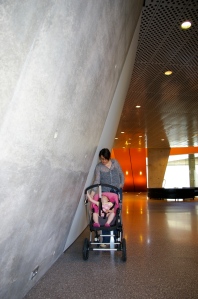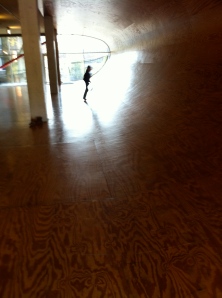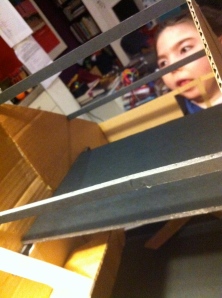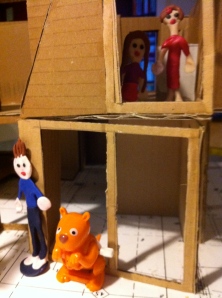http://www.wordle.net/create
News
Thanks to a temporary ramp, Greta can now get into her new room on the first floor! Whilst the build is racing on everyday (regardless of all the rain) I am spending most of my time sourcing and applying to charities for funding to help us build the house. Unfortunately, over a year ago our local council stopped funding extensions to make houses accessible, and are now only able to support a wet room and a ramp up to the front door. Quite how families are expected to carry on using their family homes, when they need to carry their ever heavier children upstairs daily, I’m not sure. As a family with a child with additional support needs, it can get very wearing to constantly focus on the difficulties of life: we like to celebrate and enjoy all the things, large and small, that we find Greta and our whole family able to do. So I don’t want to dwell on the lack of support that the Council is able to provide. But it does mean that I am having to be creative in finding ways of funding this build (any suggestions welcome!). It is a really interesting process, and I am finding out about so many wonderful charities and foundations which have been set up, often due to people’s experiences, who provide so much help support and understanding for so many people. Unfortunately, a lot of charities don’t help with building adaptations: again I’m not sure why not, people’s homes are so important to them, and they need to work well in supporting and enabling them. It may seem as if we are in a very lucky situation of being able to build our own house, which we are, and we really appreciate all the support (and kind wishes) which we get from everyone we encounter; for us this is not only the best possibility, but the only possibility. To find a house in Portobello (where Greta is known and loved) which we could afford, and which we could then adapt to make it barrier-free would be impossible. Building from scratch gives us the chance to provide a house which will carry on supporting us as a family, and helping Greta’s growing independence into the future, but it also gives us the joy of seeing Greta enjoying the spaces of our home inclusively.
Whilst the build is racing on everyday (regardless of all the rain) I am spending most of my time sourcing and applying to charities for funding to help us build the house. Unfortunately, over a year ago our local council stopped funding extensions to make houses accessible, and are now only able to support a wet room and a ramp up to the front door. Quite how families are expected to carry on using their family homes, when they need to carry their ever heavier children upstairs daily, I’m not sure. As a family with a child with additional support needs, it can get very wearing to constantly focus on the difficulties of life: we like to celebrate and enjoy all the things, large and small, that we find Greta and our whole family able to do. So I don’t want to dwell on the lack of support that the Council is able to provide. But it does mean that I am having to be creative in finding ways of funding this build (any suggestions welcome!). It is a really interesting process, and I am finding out about so many wonderful charities and foundations which have been set up, often due to people’s experiences, who provide so much help support and understanding for so many people. Unfortunately, a lot of charities don’t help with building adaptations: again I’m not sure why not, people’s homes are so important to them, and they need to work well in supporting and enabling them. It may seem as if we are in a very lucky situation of being able to build our own house, which we are, and we really appreciate all the support (and kind wishes) which we get from everyone we encounter; for us this is not only the best possibility, but the only possibility. To find a house in Portobello (where Greta is known and loved) which we could afford, and which we could then adapt to make it barrier-free would be impossible. Building from scratch gives us the chance to provide a house which will carry on supporting us as a family, and helping Greta’s growing independence into the future, but it also gives us the joy of seeing Greta enjoying the spaces of our home inclusively.
Any suggestions of creative fund raising ideas, please comment below.
Why would you choose to build your own house? As architects there is always a desire to create the spaces that you dream of, but this isn’t necessarily enough to give the impetus to actually start such a demanding project.
But what if most places you went to worked against you moving easily around it, every entrance was an obstacle to getting into the building, and every space had been designed with a mobile, upright person in mind?
For our seven year old daughter, Greta, this is a daily occurrence: she cannot yet walk on her own, so she has a collection of wheeled buggies and a bicycle. As architects, we spend a lot of time visiting buildings, and as a child in a family of architects she and her sister have learnt to love exploring different spaces and places with us. And there are many that she loves being in. But many of them seem to have been designed specifically to hinder anyone who is not conventionally mobile. There are so many missed opportunities in our architectural spaces and places.
So when we realised that Greta would need to live in a very supportive environment, we knew that was something that we could offer her. And it has been very exciting realising that an inclusive, barrier-free house is not just about being able to get from one floor to the other, or from the kitchen to the bedroom; when you consider movement around a house in a whole new way, it also offers a richness of experience of spaces that is beneficial to everyone.
One of the most important things about designing our accessible family home, was that it should be a place that belongs to the children as much as it does to us; the best way to ensure this is to include them in the design process




















